Abstract
The purpose of this study was to identify factors associated with weight loss and weight loss maintenance in 23 African American women participating in a 32-week lifestyle enhancement awareness program (LEAP), 16 weekly sessions on weight loss and 16 weekly sessions on weight loss maintenance. A pre-test, post-test one group design was used. Measures included dietary readiness to lose weight, bioelectrical impedance analysis, lipid levels, blood pressure, waist/hip ratio, weight, height, and activity level. Women who completed the weight loss phase of the program showed a reduction in weight; body mass index; percentage body fat; and waist/hip ratio; and an increase in physical activity and dietary readiness to control over-eating. Weight loss was significantly correlated with attendance and dietary readiness to decrease emotional eating. Women who continued on to complete the weight loss maintenance classes maintained a significant loss in body mass index, and increased their high-density lipoproteins and dietary readiness to monitor hunger and eating cues. African-American women who sustain weight loss and weight loss maintenance regimens reduce their risks for developing chronic diseases.
Full text
PDF
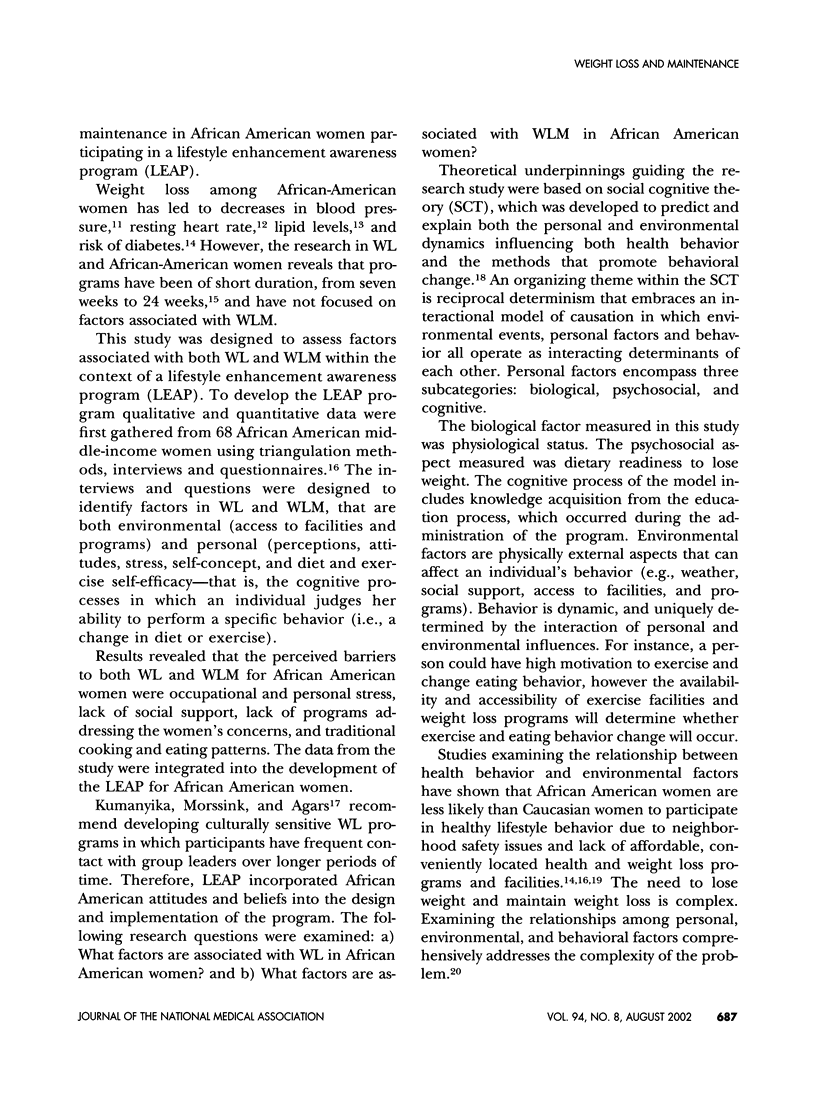

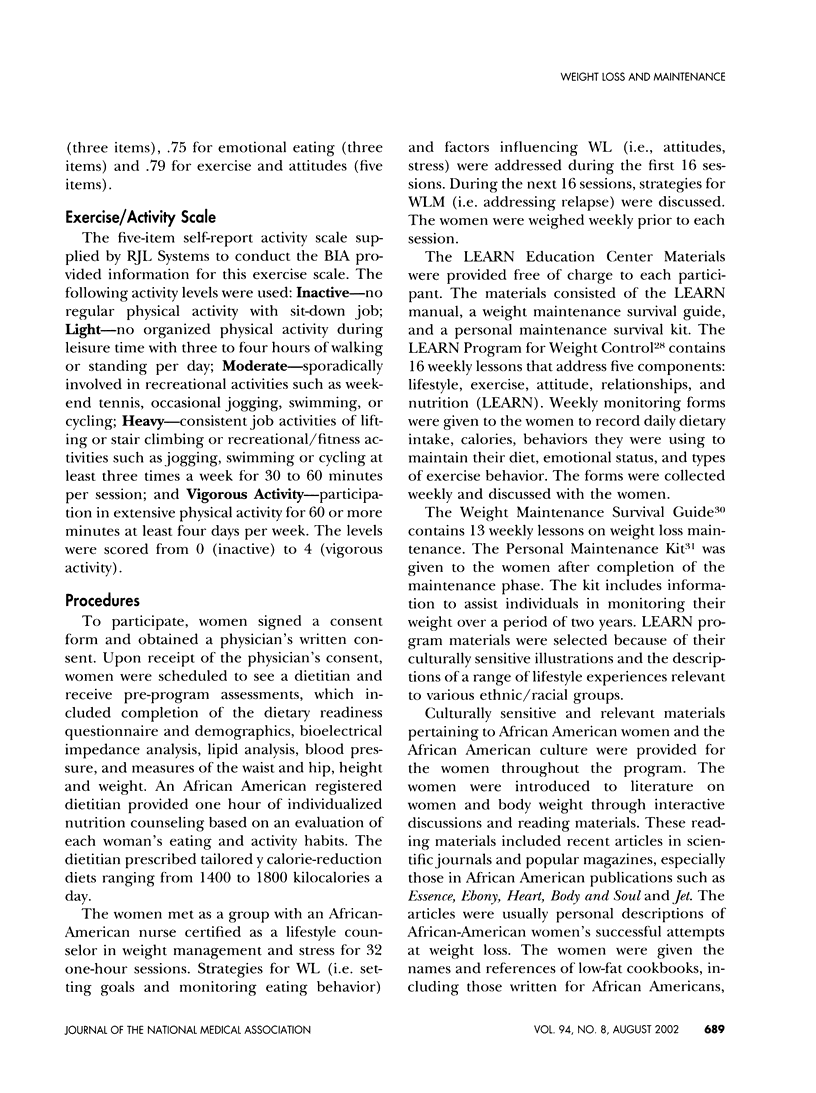
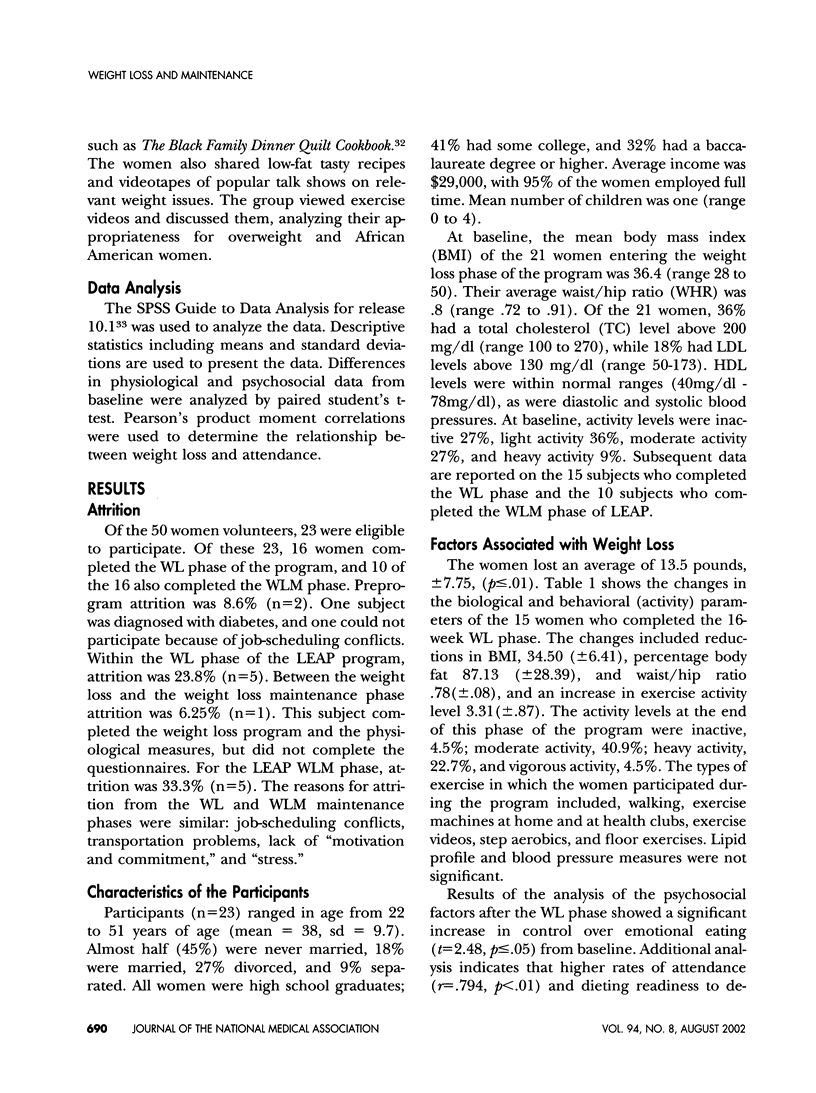

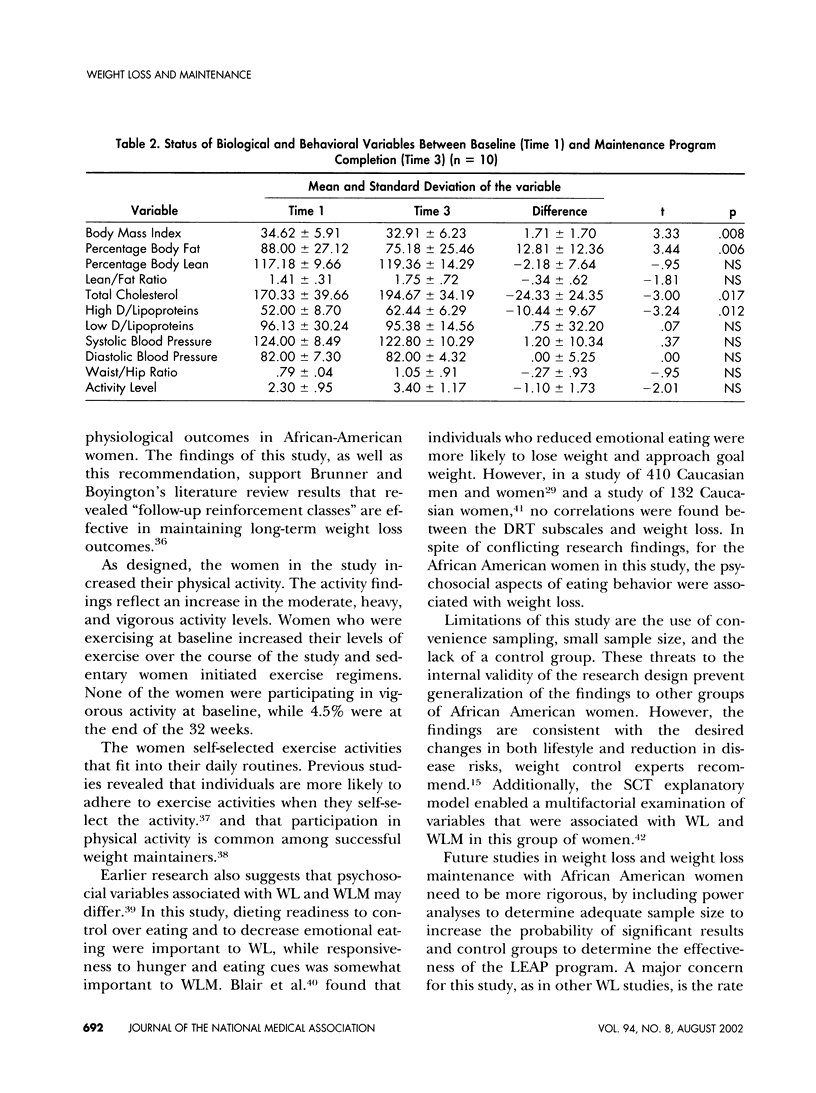
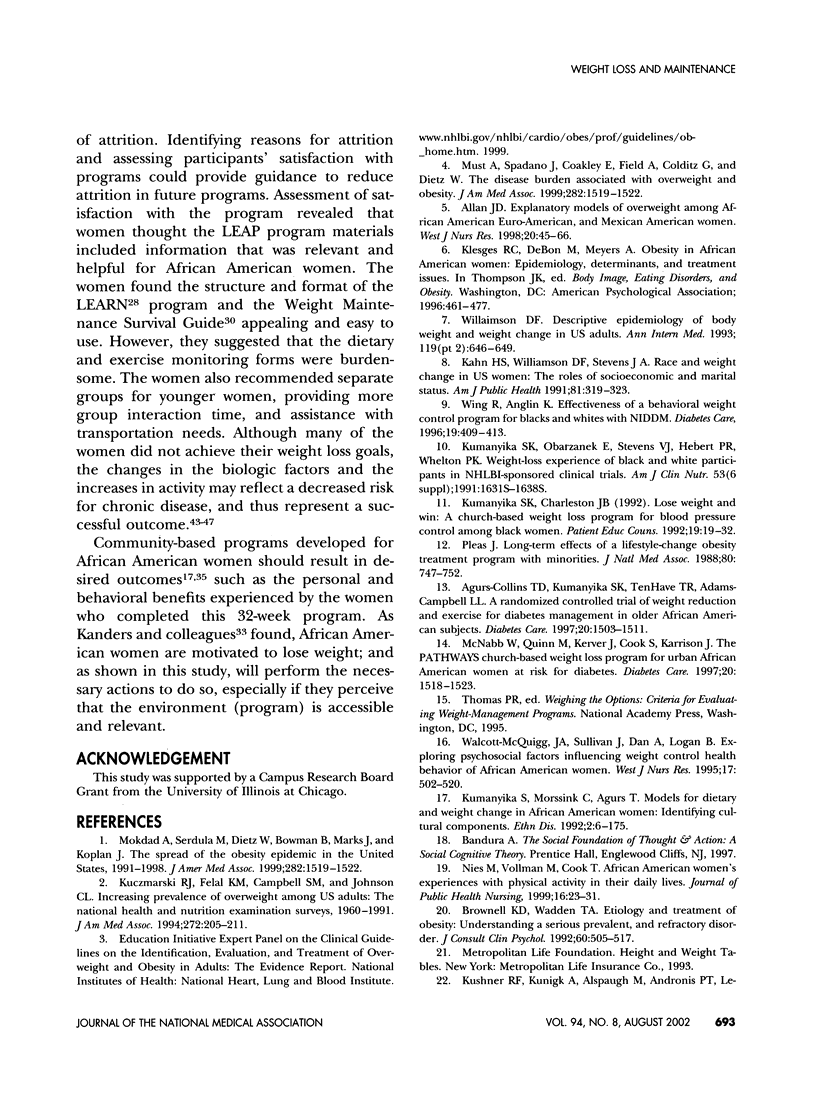

Selected References
These references are in PubMed. This may not be the complete list of references from this article.
- Agurs-Collins T. D., Kumanyika S. K., Ten Have T. R., Adams-Campbell L. L. A randomized controlled trial of weight reduction and exercise for diabetes management in older African-American subjects. Diabetes Care. 1997 Oct;20(10):1503–1511. doi: 10.2337/diacare.20.10.1503. [DOI] [PubMed] [Google Scholar]
- Allan J. D. Explanatory models of overweight among African American, Euro-American, and Mexican American women. West J Nurs Res. 1998 Feb;20(1):45–66. doi: 10.1177/019394599802000104. [DOI] [PubMed] [Google Scholar]
- Atkinson R. L. Proposed standards for judging the success of the treatment of obesity. Ann Intern Med. 1993 Oct 1;119(7 Pt 2):677–680. doi: 10.7326/0003-4819-119-7_part_2-199310011-00010. [DOI] [PubMed] [Google Scholar]
- Blair A. J., Lewis V. J., Booth D. A. Does emotional eating interfere with success in attempts at weight control? Appetite. 1990 Oct;15(2):151–157. doi: 10.1016/0195-6663(90)90047-c. [DOI] [PubMed] [Google Scholar]
- Bronner Yvonne, Boyington Josephine E. A. Developing weight loss interventions for African-American women: elements of successful models. J Natl Med Assoc. 2002 Apr;94(4):224–235. [PMC free article] [PubMed] [Google Scholar]
- Brownell K. D., Wadden T. A. Etiology and treatment of obesity: understanding a serious, prevalent, and refractory disorder. J Consult Clin Psychol. 1992 Aug;60(4):505–517. doi: 10.1037//0022-006x.60.4.505. [DOI] [PubMed] [Google Scholar]
- Fontaine K. R., Cheskin L. J., Allison D. B. Predicting treatment attendance and weight loss: assessing the psychometric properties and predictive validity of the Dieting Readiness Test. J Pers Assess. 1997 Feb;68(1):173–183. doi: 10.1207/s15327752jpa6801_14. [DOI] [PubMed] [Google Scholar]
- Hyman F. N., Sempos E., Saltsman J., Glinsmann W. H. Evidence for success of caloric restriction in weight loss and control. Summary of data from industry. Ann Intern Med. 1993 Oct 1;119(7 Pt 2):681–687. doi: 10.7326/0003-4819-119-7_part_2-199310011-00011. [DOI] [PubMed] [Google Scholar]
- Kahn H. S., Williamson D. F., Stevens J. A. Race and weight change in US women: the roles of socioeconomic and marital status. Am J Public Health. 1991 Mar;81(3):319–323. doi: 10.2105/ajph.81.3.319. [DOI] [PMC free article] [PubMed] [Google Scholar]
- Kanders B. S., Ullmann-Joy P., Foreyt J. P., Heymsfield S. B., Heber D., Elashoff R. M., Ashley J. M., Reeves R. S., Blackburn G. L. The black American lifestyle intervention (BALI): the design of a weight loss program for working-class African-American women. J Am Diet Assoc. 1994 Mar;94(3):310–312. doi: 10.1016/0002-8223(94)90374-3. [DOI] [PubMed] [Google Scholar]
- King A. C., Blair S. N., Bild D. E., Dishman R. K., Dubbert P. M., Marcus B. H., Oldridge N. B., Paffenbarger R. S., Jr, Powell K. E., Yeager K. K. Determinants of physical activity and interventions in adults. Med Sci Sports Exerc. 1992 Jun;24(6 Suppl):S221–S236. [PubMed] [Google Scholar]
- Klem M. L., Wing R. R., McGuire M. T., Seagle H. M., Hill J. O. A descriptive study of individuals successful at long-term maintenance of substantial weight loss. Am J Clin Nutr. 1997 Aug;66(2):239–246. doi: 10.1093/ajcn/66.2.239. [DOI] [PubMed] [Google Scholar]
- Kuczmarski R. J., Flegal K. M., Campbell S. M., Johnson C. L. Increasing prevalence of overweight among US adults. The National Health and Nutrition Examination Surveys, 1960 to 1991. JAMA. 1994 Jul 20;272(3):205–211. doi: 10.1001/jama.272.3.205. [DOI] [PubMed] [Google Scholar]
- Kumanyika S. K., Charleston J. B. Lose weight and win: a church-based weight loss program for blood pressure control among black women. Patient Educ Couns. 1992 Feb;19(1):19–32. doi: 10.1016/0738-3991(92)90099-5. [DOI] [PubMed] [Google Scholar]
- Kumanyika S. K., Morssink C., Agurs T. Models for dietary and weight change in African-American women: identifying cultural components. Ethn Dis. 1992 Spring;2(2):166–175. [PubMed] [Google Scholar]
- Kumanyika S. K., Obarzanek E., Stevens V. J., Hebert P. R., Whelton P. K., Kumanyaka S. K. Weight-loss experience of black and white participants in NHLBI-sponsored clinical trials. Am J Clin Nutr. 1991 Jun;53(6 Suppl):1631S–1638S. doi: 10.1093/ajcn/53.6.1631S. [DOI] [PubMed] [Google Scholar]
- Kushner R. F., Kunigk A., Alspaugh M., Andronis P. T., Leitch C. A., Schoeller D. A. Validation of bioelectrical-impedance analysis as a measurement of change in body composition in obesity. Am J Clin Nutr. 1990 Aug;52(2):219–223. doi: 10.1093/ajcn/52.2.219. [DOI] [PubMed] [Google Scholar]
- Lukaski H. C., Bolonchuk W. W. Estimation of body fluid volumes using tetrapolar bioelectrical impedance measurements. Aviat Space Environ Med. 1988 Dec;59(12):1163–1169. [PubMed] [Google Scholar]
- Lukaski H. C., Bolonchuk W. W., Hall C. B., Siders W. A. Validation of tetrapolar bioelectrical impedance method to assess human body composition. J Appl Physiol (1985) 1986 Apr;60(4):1327–1332. doi: 10.1152/jappl.1986.60.4.1327. [DOI] [PubMed] [Google Scholar]
- Manson J. E., Colditz G. A., Stampfer M. J., Willett W. C., Rosner B., Monson R. R., Speizer F. E., Hennekens C. H. A prospective study of obesity and risk of coronary heart disease in women. N Engl J Med. 1990 Mar 29;322(13):882–889. doi: 10.1056/NEJM199003293221303. [DOI] [PubMed] [Google Scholar]
- McNabb W., Quinn M., Kerver J., Cook S., Karrison T. The PATHWAYS church-based weight loss program for urban African-American women at risk for diabetes. Diabetes Care. 1997 Oct;20(10):1518–1523. doi: 10.2337/diacare.20.10.1518. [DOI] [PubMed] [Google Scholar]
- Mokdad A. H., Serdula M. K., Dietz W. H., Bowman B. A., Marks J. S., Koplan J. P. The spread of the obesity epidemic in the United States, 1991-1998. JAMA. 1999 Oct 27;282(16):1519–1522. doi: 10.1001/jama.282.16.1519. [DOI] [PubMed] [Google Scholar]
- Mokdad A. H., Serdula M. K., Dietz W. H., Bowman B. A., Marks J. S., Koplan J. P. The spread of the obesity epidemic in the United States, 1991-1998. JAMA. 1999 Oct 27;282(16):1519–1522. doi: 10.1001/jama.282.16.1519. [DOI] [PubMed] [Google Scholar]
- Nies M. A., Vollman M., Cook T. African American women's experiences with physical activity in their daily lives. Public Health Nurs. 1999 Feb;16(1):23–31. doi: 10.1046/j.1525-1446.1999.00023.x. [DOI] [PubMed] [Google Scholar]
- Pendleton V. R., Poston W. S., 2nd, Goodrick G. K., Willems E. P., Swank P. R., Kimball K. T., Foreyt J. P. The predictive validity of the Diet Readiness Test in a clinical population. Int J Eat Disord. 1998 Dec;24(4):363–369. doi: 10.1002/(sici)1098-108x(199812)24:4<363::aid-eat3>3.0.co;2-s. [DOI] [PubMed] [Google Scholar]
- Pleas J. Long-term effects of a lifestyle-change obesity treatment program with minorities. J Natl Med Assoc. 1988 Jul;80(7):747–752. [PMC free article] [PubMed] [Google Scholar]
- Pratt C. A., McLaughlin G. W., Gaylord C. A multivariate analysis of weight-loss behavior. Psychol Rep. 1992 Dec;71(3 Pt 2):1075–1084. doi: 10.2466/pr0.1992.71.3f.1075. [DOI] [PubMed] [Google Scholar]
- Rogers E. J., Misner L., Ockene I. S., Nicolosi R. J. Evaluation of seven Cholestech L.D.X analyzers for total cholesterol determinations. Clin Chem. 1993 May;39(5):860–864. [PubMed] [Google Scholar]
- Walcott-McQuigg J. A., Sullivan J., Dan A., Logan B. Psychosocial factors influencing weight control behavior of African American women. West J Nurs Res. 1995 Oct;17(5):502–520. doi: 10.1177/019394599501700504. [DOI] [PubMed] [Google Scholar]
- Williamson D. F. Descriptive epidemiology of body weight and weight change in U.S. adults. Ann Intern Med. 1993 Oct 1;119(7 Pt 2):646–649. doi: 10.7326/0003-4819-119-7_part_2-199310011-00004. [DOI] [PubMed] [Google Scholar]
- Wing R. R., Anglin K. Effectiveness of a behavioral weight control program for blacks and whites with NIDDM. Diabetes Care. 1996 May;19(5):409–413. doi: 10.2337/diacare.19.5.409. [DOI] [PubMed] [Google Scholar]
- Wood P. D., Stefanick M. L., Williams P. T., Haskell W. L. The effects on plasma lipoproteins of a prudent weight-reducing diet, with or without exercise, in overweight men and women. N Engl J Med. 1991 Aug 15;325(7):461–466. doi: 10.1056/NEJM199108153250703. [DOI] [PubMed] [Google Scholar]


